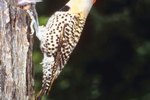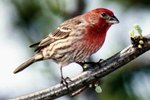
Hummingbirds present an intriguing topic of conversation for many North American birdwatchers. Although scientists have identified more than 300 hummingbird species, most of these tiny birds reside in the tropics. North America hosts 112 species, with 26 types seen north of the Mexican border. The southwestern United States harbors many migrants and residents, with southeastern Arizona an ideal viewing spot for multiple species.
Anna's Hummingbird
Anna's hummingbirds populate much of the Pacific Coast, taking up residence in eucalyptus groves, parks, coastal scrub habitats and hospitable backyards. Males of the species boast luminous green feathers and rich pinkish-rose throats, making them quite visible as they whirl through the air during courtship behaviors. In fact, a male often soars 130 feet high before executing a spectacular dive to the ground, complete with unusual noises emanating from his tail feathers.
Costa's Hummingbird
Costa's hummingbirds spend the cooler breeding months in the Arizona and California deserts, migrating to more habitable woodland and scrub environments during the blistering desert summer months. The Costa male's greenish back contrasts with his brilliant purple head and throat, making him quite visible against the desert and scrub vegetation. The hummingbirds' habitats have become threatened by development and flood control project land preparation. In addition, cattle farmers have replaced desert scrub vegetation with South African buffelgrass, which feeds fires that destroy Costa's hummingbirds' nesting spots and nectar sources.
Ruby-throated Hummingbird
Ruby-throated hummingbirds provide a welcome reminder of spring throughout the eastern United States. After the tiny travelers traverse the Gulf of Mexico from their Central American winter homes, the ruby-throats settle in meadows, parks, gardens and suburban backyards. Male ruby-throats' greenish backs and rich red throats make them easy for females to spot, leading to mating and nesting behaviors, and ultimately resulting in ruby-throated offspring. In early fall, the hummingbirds' instincts spur them to head south again.
Rufous Hummingbird
Rufous hummingbirds follow seasonal weather patterns throughout the U.S. and Mexico. During the summer, the rufous species settles throughout the northwestern U.S., breeding and nesting in spacious parks and woodlands. While rufous hummingbirds occasionally winter in the Southeast and southern California, they generally spend the winter months in Mexico. Rufous males' orange back coloring may be flecked with green, contrasting with many plants and trees. The rufous males' wings only produce the distinctive buzzing sound when they actually fly, not when they hover.
References
- Audubon California Kern River Preserve: Hummingbird Facts
- The Cornell Lab of Ornithology: All About Birds: Anna's Hummingbird
- The Cornell Lab of Ornithology: All About Birds: Costa's Hummingbird
- Audubon: Costa's Hummingbird
- The Cornell Lab of Ornithology: All About Birds: Ruby-throated Hummingbird
- National Geographic: Rufous Hummingbird
Photo Credits
-
NA/Photos.com/Getty Images
Writer Bio
Based in North Carolina, Felicia Greene has written professionally since 1986. Greene edited sailing-related newsletters and designed marketing programs for the New Bern, N.C. "Sun Journal" and New Bern Habitat ReStore. She earned a Bachelor of Science in business administration from the University of Baltimore.




